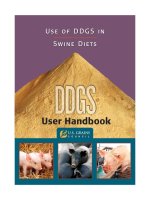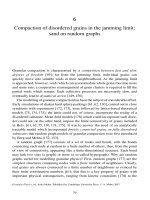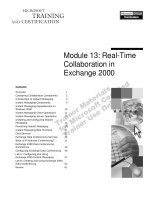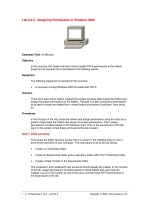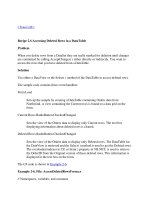DISTILLERS GRAINS IN POULTRY DIETS pptx
Bạn đang xem bản rút gọn của tài liệu. Xem và tải ngay bản đầy đủ của tài liệu tại đây (111.6 KB, 9 trang )
DISTILLERS GRAINS IN POULTRY DIETS
S. Noll, V. Stangeland, G. Speers and J. Brannon
University of Minnesota
Anticipation of increased supplies of distiller’s dried grains with solubles (DDGS) in the
Midwest has rekindled the interest in utilization of this by-product in animal feeds. In the
Midwest US, corn is the primary feed stock although other grains can be processed as well.
With increasing numbers of chicken layers and a large turkey industry in the Midwest, use of
DDGS in poultry diets appears to have potential. Unfortunately, there is limited recent research
for this ingredient with modern strains of poultry.
In the dry mill production of ethanol two products are produced – liquid solubles and grain
residue. Each could be dried separately but are mixed together to form DDGS as a dry
ingredient. Some of the liquid solubles have been fed experimentally with acceptable results
(Hunt et al., 1997) but usually the product is fed after drying. DDGS as a feed ingredient has a
moderate protein content and energy level similar to soybean meal. As a sole source of protein
in diet, Parsons and coworkers (1983) found DDGS to be limiting in tryptophan and arginine
after lysine.
An early use of DDGS in poultry diests was primarily as a source of unidentified factors that
promote growth and hatchability. Distillers dried solubles (DDS) or DDGS were used in diets at
low levels of inclusion usually less than 10%. Couch et al. (1957) found 5% inclusion of DDS
variably improved turkey growth rates with the response ranging from 17-32%. Day et al (1972)
reported broiler body weight improvements to DDS and DDGS in broiler diets at 2.5 and 5% in
one of 3 trials. Improved reproductive performance has also been indicated for turkey breeder
hens. Couch et al (1957) found improvements in turkey breeder hatchability during the second
half of lay with inclusion of dried alfalfa meal, condensed fish solubles, and DDS. Manley et al
(1978) found 3% DDGS improved egg production in hens late in lay and experiencing a low rate
of egg production. In diets low in phosphorus DDGS was particularly valuable in improving egg
production. However, in a subsequent report, no benefits were observed without low dietary
phosphorus (Grizzle et al., 1982). Some have hypothesized that the UGF response may partially
be due to alteration of feed palatability. Alenier and Combs (1981) noted chicken layer hens
preferred rations containing 10% DDGS or 15% DDS over a corn-soy diet without DDGS.
Cantor and Johnson (1983) were unable to document an effect with distillers in corn soy diets for
young chicks. With identification of essential nutrients and availability of commercial
supplements, UGF sources are often looked upon with skepticism (Leeson and Summers).
Use of DDGS has also been examined at high levels of inclusion. When lysine levels were
adjusted in turkey diets, similar body weights were obtained with DDGS inclusion up to 20% of
the diet to 8 wks of age; but feed conversion worsened (Potter, 1966). Parsons et al. (1983)
found that DDGS could replace up to 40% of soybean meal protein when lysine content was
adjusted without an effect on body weight. When energy is also adjusted body weights and feed
conversions are not affected by inclusion of distillers to high levels. Waldroup et al (1981)
included DDGS to 25% of diet for broilers. When adjusted for lysine and energy level,
performance was not affected. Without adjustment for energy, growth was maintained but feed
conversion decreased. Caloric intake per gain was similar across all treatments.
Despite the above research results, nutritionists are hesitant to use high inclusion levels in the
diet. The lower energy (less starch) and higher fiber content is a concern and high dietary levels
may limit intake of high performance meat poultry. Variability in product nutrient content and
quality is often cited. Indeed, variability exists in nutrient content and performance response. In
the report presented by Cromwell and coworkers (1993), 9 different samples of DDGS were
analyzed and tested in chick diets. A large range of lysine contents were noted (.43 to .89%).
Chick responses to inclusion of these same samples (20%) in isonitrogenous and isocaloric diets
ranged from 63 to 84% of the corn-soy-starch control. Samples higher in lysine tended to
perform better but some samples did not follow this pattern.
As distiller grains undergo heating to produce the dried product, concern exists over amino acid
digestibility especially for heating of lysine in the presence of sugars. Indeed the limited
literature citations indicate poorer availability of lysine. Combs and Bossard (1969) found lysine
availability to range from 71-93% by chick growth assay. Parsons et al (1983) found slightly
lower availability of 66% by chick growth assay. Lysine digestibility with roosters was found to
be 82%. Other sources also assign a low digestibility to DDGS.
With the paucity of research and new developments in production of DDGS, inclusion levels and
digestibility should be reconsidered. In the Midwest, a variety of ingredients are available and
may be cost effective when considering both ingredient cost and effects on performance.
Besides soybean meal, meat and bone meal and canola meal is often available. Along with corn
and SBM, these ingredients are often used in market poultry diets. Meat and bone meal is a good
source of protein and offers other nutrients such as calcium and phosphorus and contributes
energy (fat) to the diet. Canola meal has benefits for pellet quality and mill throughput.
Utilization of other ingredients such as DDGS needs to be evaluated in such diets with an
emphasis on protein quality or amino acid balance as performance and breast meat yield is
greatly impacted by intake of specific amino acids.
Thus a study was designed to examine if significant levels of canola meal and DDGS can be
used in market turkey diets and to determine which amino acids (tryptophan, isoleucine,
arginine) may limit performance with diets containing canola and DDGS.
Nicholas male poults were placed in starting pens at one day of age and reared to 5 weeks of age.
Poults were fed a pre-experimental diet designed for best rate of gain. At 5 weeks of age the
birds were randomly distributed into 98 pens with 10 birds per pen. Room temperature at 5 wks
was targeted at 70 F. In the other room temperature was gradually decreased to 60 F at 14 wks
of age and a minimum of 55 F held for the remaining experimental period.
Starting at 5 wks of age, the toms in each environment (cool and warm temperature
environments) were fed one of seven dietary treatments with 7 replicates per treatment.
Treatments
1. Control - Corn/soy/animal protein
2. As 1 plus corn DDGS
3. As 1 plus Canola meal
4. As 1 plus DDGS and Canola meal
5. As 4 plus Tryptophan to Trt 1
6. As 4 plus Tryptophan and Isoleucine to Trt 1
7. As 4 plus Tryptophan, Arginine, and Isoleucine to Trt 1
All major diet ingredients were analyzed for nutrient content and digestible amino acids (Table
1). Ingredients were chemically analyzed for protein, minerals and amino acids. Samples of
each ingredient were submitted to Dr. Parson at the University of Illinois for determination of
digestible amino acids using cecatomized chickens.
Sample diets are shown in Tables 2 and 3 for the respective 5-8 and 17-19 wk periods for
Treatments 1 through 4. The control diet (Treatment 1) includes animal protein because of its
obvious economic advantage and widespread use. Valine content (as a percent of protein) is
similar across ingredients; therefore diet protein in these sample diets was fixed by setting a
valine specification. Supplemental lysine, methionine, and threonine were used so that all diets
contained adequate amounts of these amino acids. For Treatments 5, 6, and 7 supplements of
tryptophan, arginine and isoleucine were used to achieve amino acid levels similar to that of
Treatment 1. All diets contained 60 gm Coban and 20gm Stafac from 5-8 wks and 20 gm Stafac
per ton alone from 8-19 wks of age. Weights and feed consumption were determined at 8, 11,
14, 17 and 19 wks of age. At 19 weeks, toms were processed and carcass and breast meat yield
determined. At this time samples of breast meat representing each treatment and environment
were measured for meat quality by obtaining color, pH, and purge loss.
The experimental design was factorial with diet and environment as the main effects. Analyses
of variance were conducted to determine the effects of diet, environment and their interaction on
gain, feed conversion, and breast meat yield.
Body weight and feed efficiency (feed/gain) were affected primarily by environment
temperature. Turkeys grown in the warm temperature environment had less body weight
especially at 19 wks of age with somewhat better feed efficiency (Table 4). Inclusion of
moderate levels of canola meal and DDGS had no adverse effects on performance in comparison
to the control diet in either environment. Both environment and diet (Table 5) affected breast
meat yield (amount and percentage). Warm temperatures depressed yield by 1.2 lbs. or 2% of
the carcass. Inclusion of either DDGS or canola meal alone had little effect on breast meat yield.
However, the inclusion of both into the diet depressed percentage meat yield significantly.
Supplementation of the diet with tryptophan restored some of the lost yield in comparison.
Isoleucine was without effect, while supplementation with arginine (in combination with
tryptophan and isoleucine) restored breast meat yield completely.
In summary, digestible amino acid content of the DDGS used in this project was much better
than reported elsewhere. Warm environmental temperatures depressed body weights by 1.8 lbs.
at 19 wks of age and breast meat amount by 1.2 lbs. Inclusion of significant levels of either
canola and/or DDGS had no effect on growth performance. Breast meat yield (as a proportion of
carcass weight) was sensitive to amino acid quality as reflected by the depression in yield when
the combined diet of canola and distiller grains were fed. The amino acids tryptophan and
arginine appeared to play a role in restoring yield.
REFERENCES
Alenier, J. C., and G. F. Combs, Jr., 1981. Effects on feed palatability of ingredients believed to
contain unidentified growth factors for poultry. Poultry Sci. 60:215-224.
Cantor, A. H., and T. H. Johnson, 1983. Effects of unidentified growth factor sources on feed
preference of chicks. Poultry Sci. 62:1281-1286.
Combs, G. F., and E. H. Bossard, 1969. Further studies on available amino acid content of corn
distillers dried grains with solubles. In “Proceedings Distillers Feed Research Council
Conference”. pp 53-58.
Couch, J.R., A.A. Kurnick, R. L. Svacha and B. L. Reid, 1957. Corn distillers dried solubles in
turkey feeds – summary and new developments. In “Proceedings Distillers Feed
Research Council Conference”. pp 71-81.
Cromwell, G. L., K. L. Herkelman, and T. S. Stahly, 1993. Physical, chemical, and nutritional
characteristics of distillers dried grains with solubles for chicks and pigs. J. Anim. Sci.
71:679-686.
Day, E. J., B. C. Dilworth, and J. McNaughton, 1972. Unidentified growth factor sources in
poultry diets. In “Proceedings Distillers Feed Research Council Conference”. pp 40-45.
Grizzle, J.M., R. A. Voitle, and R. H. Harms, 1982. Evaluation of distillers dried grains with
solubles in diets of turkey hens. Poultry Sci. 61:1363-1366.
Hunt, J. H., J. J. Lyons, and J. M. Vandepopuliere, 1997. Corn stillage as a feedstuff for broilers
and turkeys. J. Appl. Poultry Res. 6:310-318.
Manley, J. M., R. A. Voitle, and R. H. Harms, 1978. The influence of distillers dried grains with
solubles (DDGS) in the diet of turkey breeder hens. Poultry Sci. 57:726-728.
Parsons, C.M., D. H. Baker, and J. M. Harter, 1983. Distillers dried grains with solubles as a
protein source for the chick. Poultry Sci. 62:2445-2451.
Potter, L. M., 1966. Studies with distillers feeds in turkey rations. In “Proceedings Distillers
Feed Research Council Conference”. pp 47-51.
Waldroup, P. W., J. A. Owen, B. E. Ramsey, and D. L. Whelchel, 1981. The use of high levels
of distillers dried grains plus solubles in broiler diets. Poultry Sci. 60:1479-1484.
Table 1. Ingredient Analyses for Turkey Feeding Trial.
Meat & Bone Meal
Corn, Ground yellow Soybean meal, 47% Distillers Grains Solubles Canola Meal Poultry Blend
Nutrient (%) Total Digestible Total Digestible Total Digestible Total Digestible Total Digestible
PROTEIN, CRUDE 8.44 46.77 26.39 37.12 58.11
DRY MATTER 87.13 88.27 90.23 89.32 95.19
FAT, CRUDE 4.67 2.31 11.51 3.45 11.37
FIBER, CRUDE 1.7 2.47 6.17 10.15 0.51
CALCIUM 0.0079 0.24 0.08 0.78 7.77
PHOSPHORUS, TOTAL 0.24 0.65 0.82 1.18 3.86
POTASSIUM 0.29 2.11 1.1 1.29 0.61
SODIUM 0.0008 0.0215 0.17 0.11 0.65
CHLORIDE 0.04 0.01 0.08 0.05 0.58
METHIONINE 0.15 0.14 0.66 0.61 0.49 0.43 0.72 0.65 1.07 0.99
CYSTINE 0.17 0.16 0.77 0.65 0.53 0.42 0.97 0.77 0.63 0.53
LYSINE 0.25 0.2 2.94 2.66 0.81 0.64 2.04 1.71 3.32 2.99
ARGININE 0.37 0.33 3.38 3.14 1.11 1.02 2.22 2.05 3.95 3.71
TRYPTOPHAN 0.06 0.05 0.66 0.58 0.24 0.192 0.5 0.45 0.52 0.468
VALINE 0.37 0.32 2.19 1.99 1.36 1.2 1.77 1.48 2.43 2.19
GLYCINE 0.3 1.93 1 1.75 6.41
HISTIDINE 0.23 0.2 1.29 1.15 0.7 0.61 1.01 0.89 1.16 1.06
PHENYLALANINE 0.41 0.37 2.37 2.19 1.26 1.16 1.44 1.3 2.02 1.87
TYROSINE 0.26 1.63 0.99 0.95 0.99 0.88 1.47 1.36
THREONINE 0.29 0.24 1.78 1.57 1 0.83 1.51 1.23 2.01 1.81
LEUCINE 1.02 0.96 3.59 3.31 3 2.82 2.53 2.28 3.63 3.37
ISOLEUCINE 0.27 0.24 2.05 1.89 0.96 0.86 1.35 1.16 1.88 1.73
SERINE 0.37 0.37 2.09 2.09 1.12 1.01 1.33 1.15 2.22 1.98
Table 2. Selected Diet Composition 5-8 Wks of Age
Control (C-S-MBM) DDGS Canola Canola & DDGS
Ingredient (%) Trt 1 Trt 2 Trt 3 Trt 4
Corn 59.95 54.09 54.81 48.95
SBM 47% 26.78 20.49 18.68 12.39
Poultry blend (meat&bone) 8 8 8 8
Distillers grains w/sol 0 12 0 12
Canola meal 0 0 12 12
Dicalcium phosphate 1.094 1.005 0.954 0.865
Calcium carbonate 0.683 0.748 0.567 0.632
Scarb 0.381 0.366 0.338 0.324
Salt 0.040 0.004 0.044 0.008
Potassium carbonate 0.004 0.036 0.060 0.093
DL-Methionine 0.184 0.179 0.131 0.125
L-Lysine 0.275 0.405 0.301 0.432
Threonine 0.077 0.091 0.069 0.082
MNVIT99 0.22 0.22 0.22 0.22
MNTM96 0.12 0.12 0.12 0.12
Choline Chloride 60% 0.125 0.125 0.125 0.125
Choice White Grease 2.06 2.12 3.57 3.63
Total 100.0 100.0 100.0 100.0
Calculated Nutrient Content
Crude Protein (%) 22.7 22.5 22.9 22.7
Metabolizable Energy (kcal/kg) 3070 3070 3070 3070
Crude fat (%) 6.4 7.4 7.9 8.9
Calcium (%) 1.18 1.18 1.18 1.18
Phosphorus, total (%) 0.83 0.86 0.88 0.91
Phosphorus, Inorganic (%) 0.59 0.59 0.59 0.59
Potassium (%) 0.79 0.79 0.79 0.79
Sodium (%) 0.19 0.19 0.19 0.19
Chloride (%) 0.22 0.22 0.22 0.22
Digestible Total Digestible Total Digestible Total Digestible Total
Met plus cys (%) 0.819 0.905 0.819 0.912 0.819 0.922 0.819 0.929
Lysine (%) 1.287 1.418 1.287 1.418 1.287 1.433 1.287 1.433
Arginine (%) 1.336 1.443 1.241 1.342 1.310 1.417 1.216 1.315
Tryptophan (%) 0.225 0.254 0.208 0.238 0.229 0.258 0.213 0.242
Valine (%) 0.900 1.003 0.900 1.006 0.900 1.019 0.900 1.022
Glycine (%) 1.210 1.21 1.190 1.19 1.248 1.248 1.229 1.229
Histidine (%) 0.513 0.576 0.502 0.566 0.516 0.581 0.505 0.57
Phenylalanine (%) 0.958 1.042 0.938 1.02 0.918 1.002 0.897 0.98
Tyrosine (%) 0.701 0.71 0.697 0.711 0.661 0.683 0.658 0.681
Threonine (%) 0.785 0.887 0.785 0.891 0.785 0.901 0.785 0.905
Leucine (%) 1.732 1.863 1.805 1.938 1.688 1.824 1.762 1.898
Isoleucine (%) 0.788 0.861 0.759 0.832 0.792 0.843 0.732 0.814
Serine (%) 0.940 0.959 0.908 0.94 0.890 0.93 0.858 0.912
Table 3. Selected Diets for 17-19 Wks of Age
Control (C-S-MBM) DDGS Canola Canola & DDGS
Nutrient (%) Trt 1 Trt 2 Trt 3 Trt 4
Corn 74.46 70.55 71.04 67.13
SBM 47% 12.67 8.48 7.28 3.08
Poultry blend (meat&bone) 5.00 5.00 5.00 5.00
Distillers grains w/solubles 0 8 0 8
Canola meal 0 0 8 8
Dicalcium phosphate 0.768 0.709 0.674 0.615
Calcium carbonate 0.563 0.606 0.485 0.529
Scarb 0.333 0.322 0.304 0.294
Salt 0.110 0.085 0.112 0.088
Potassium carbonate 0.011 0.033 0.049 0.070
DL-Methionine 0.042 0.039 0.006 0.003
L-Lysine 0.154 0.241 0.171 0.258
Threonine 0.022 0.031 0.017 0.026
MNVIT99 0.17 0.17 0.17 0.17
MNTM96 0.08 0.08 0.08 0.08
Choline Chloride 60% 0.1 0.1 0.1 0.1
Choice White Grease 5.51 5.55 6.52 6.56
Total 100.0 100.0 100.0 100.0
Nutrient
Crude Protein (%) 14.6 14.6 14.8 14.7
Metabolizable Energy (kcal/kg) 3390 3390 3390 3390
Crude fat (%) 9.9 10.5 10.8 11.5
Calcium (%) 0.80 0.80 0.80 0.80
Phosphorus, total (%) 0.60 0.61 0.63 0.65
Phosphorus, inorganic (%) 0.40 0.40 0.40 0.40
Potassium (%) 0.52 0.52 0.52 0.52
Sodium (%) 0.18 0.18 0.18 0.18
Chloride (%) 0.22 0.22 0.22 0.22
Digestible Total Digestible Total Digestible Total Digestible Total
Met + Cys (%) 0.495 0.546 0.495 0.552 0.495 0.558 0.495 0.563
Lysine (%) 0.756 0.845 0.756 0.845 0.756 0.855 0.756 0.855
Arginine (%) 0.829 0.901 0.766 0.834 0.812 0.884 0.749 0.816
Tryptophan (%) 0.134 0.154 0.123 0.143 0.137 0.157 0.126 0.146
Valine (%) 0.600 0.675 0.600 0.677 0.600 0.685 0.600 0.688
Glycine (%) 0.789 0.789 0.776 0.776 0.814 0.814 0.801 0.801
Histidine (%) 0.348 0.393 0.340 0.386 0.350 0.396 0.343 0.389
Phenylalanine (%) 0.647 0.707 0.633 0.692 0.620 0.68 0.606 0.665
Tyrosine (%) 0.468 0.474 0.466 0.474 0.442 0.456 0.439 0.457
Threonine (%) 0.490 0.564 0.490 0.567 0.490 0.573 0.490 0.576
Leucine (%) 1.303 1.396 1.352 1.446 1.274 1.37 1.323 1.419
Isoleucine (%) 0.505 0.555 0.485 0.535 0.487 0.543 0.467 0.523
Serine (%) 0.639 0.651 0.618 0.639 0.606 0.632 0.585 0.62
Table 4. Performance of Male Market Turkeys
Feed
Diet Body Weight Efficiency
Number Description 11 wks 19 wks 5-19 wks
lbs feed/gain
1 Control (Corn-Soybean-Animal Protein) 18.9 42.7 2.517
2 As 1 + Distillers Dried Grains 19.0 42.6 2.635
3 As 1 + Canola Meal 19.1 43.1 2.679
4 As 1 + Distillers Dried Grains & Canola Meal 19.1 42.8 2.650
5 As 4 + Tryptophan to Trt #1 19.1 42.6 2.860
6 As 5 + Isoleucine to Trt #1 19.0 43.2 2.592
7 As 6 + Arginine to Trt #1 18.9 42.9 2.619
Cool Environment 19.0 42.8 2.650
1 Control (Corn-Soybean-Animal Protein) 18.4 40.6 2.515
2 As 1 + Distillers Dried Grains 18.5 41.2 2.536
3 As 1 + Canola Meal 18.7 41.3 2.543
4 As 1 + Distillers Dried Grains & Canola Meal 18.6 40.9 2.522
5 As 4 + Tryptophan to Trt #1 18.9 41.2 2.581
6 As 5 + Isoleucine to Trt #1 18.4 40.2 2.511
7 As 6 + Arginine to Trt #1 18.6 41.5 2.529
Warm Environment 18.6 41.0 2.534
1 Control (Corn-Soybean-Animal Protein) 18.6 41.6 2.516
2 As 1 + Distillers Dried Grains 18.7 41.9 2.586
3 As 1 + Canola Meal 18.9 42.2 2.611
4 As 1 + Distillers Dried Grains & Canola Meal 18.8 41.8 2.586
5 As 4 + Tryptophan to Trt #1 19.0 41.9 2.721
6 As 5 + Isoleucine to Trt #1 18.7 41.7 2.551
7 As 6 + Arginine to Trt #1 18.8 42.2 2.574
Average 18.8 41.9 2.592
P Value
Diet NS NS 0.0183
Room 0.0001 0.0001 0.0002
Diet x Room NS NS NS
Least Significant Difference (P<.05)
Diet 0.3 0.7 0.109
Room 0.2 0.4 0.059
Table 5. Carcass yield of market tom turkeys
% of
Diet Body Wt Carcass
Number Description 19 wks Carcass Breast Breast
lbs %
1 Control (Corn-Soybean-Animal Protein) 42.51 33.41 10.65 31.83
2 As 1 + Distillers Dried Grains 43.14 34.28 10.84 31.59
3 As 1 + Canola Meal 42.93 34.10 10.90 31.90
4 As 1 + Distillers Dried Grains & Canola Meal 42.75 33.65 10.48 31.08
5 As 4 + Tryptophan to Trt #1 42.24 33.25 10.45 31.37
6 As 5 + Isoleucine to Trt #1 42.87 34.05 10.59 31.02
7 As 6 + Arginine to Trt #1 42.92 33.93 10.73 31.54
Cool Environment 42.76 33.81 10.66 31.48
1 Control (Corn-Soybean-Animal Protein) 39.96 31.36 9.32 29.65
2 As 1 + Distillers Dried Grains 40.94 32.14 9.42 29.30
3 As 1 + Canola Meal 41.32 32.50 9.71 29.86
4 As 1 + Distillers Dried Grains & Canola Meal 40.68 31.76 9.15 28.78
5 As 4 + Tryptophan to Trt #1 41.25 32.44 9.57 29.48
6 As 5 + Isoleucine to Trt #1 40.52 31.65 9.17 28.93
7 As 6 + Arginine to Trt #1 41.42 32.57 9.78 30.01
Warm Environment 40.87 32.06 9.45 29.43
1 Control (Corn-Soybean-Animal Protein) 41.23 32.39 9.99 30.74
2 As 1 + Distillers Dried Grains 42.04 33.21 10.13 30.45
3 As 1 + Canola Meal 42.13 33.30 10.30 30.88
4 As 1 + Distillers Dried Grains & Canola Meal 41.72 32.71 9.81 29.93
5 As 4 + Tryptophan to Trt #1 41.74 32.84 10.01 30.43
6 As 5 + Isoleucine to Trt #1 41.69 32.85 9.88 29.98
7 As 6 + Arginine to Trt #1 42.17 33.25 10.25 30.78
Average 41.82 32.93 10.05 30.45
P Value
Diet NS NS NS 0.0206
Room 0.0001 0.0001 0.0001 0.0001
Diet x Room NS NS NS NS
Least Significant Difference (P<.05)
Diet 0.94 0.86 0.39 0.65
Room 0.50 0.46 0.21 0.35
